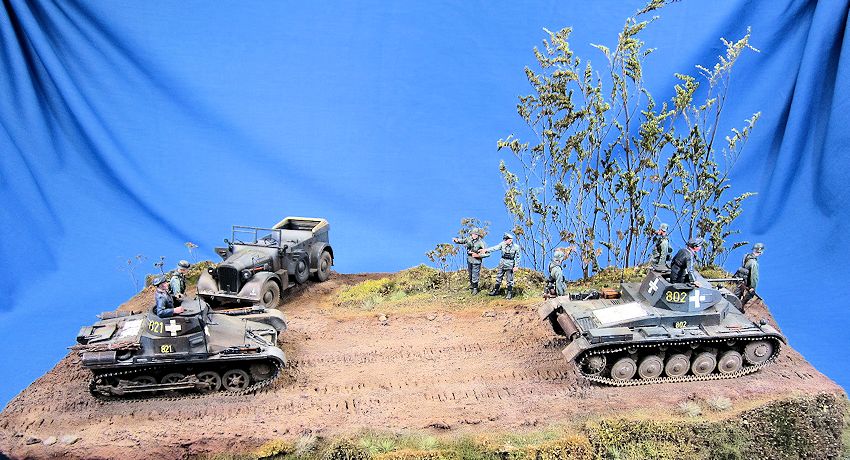
| KIT #: | See Notes |
| PRICE: | $ |
| DECALS: | |
| REVIEWER: | Scott Lyle |
| NOTES: |
1/35
Italeri #6215, Kfz. 15 Horch, $35-40 in stores.
1/35
Tamiya #35292, German Panzerkampfwagen II Ausf. A/B/C (Sd.Kfz.121);
$45-50 in stores.
1/35 Tristar #35008, German Panzer I Ausf.
A Late, about $35 on ebay |

| HISTORY |
It
can be said that World War Two was all but inevitable shortly after the close of
World War One. It didn’t have to be
that way, but the horrors of trench warfare, with its terrible cost in lives and
material, made the Allies extra harsh when they presented their surrender terms
to the defeated Germans. Instead of
recognizing Germany as a world power, the Allies sought to turn Germany into a
second class nation. The result was
a once-proud country saddled with a crippled economy, explosive rates of
inflation, and a population on the edge.
By the early 1930s the German people were so desperate that conditions
were ripe for an extremist political movement to come to the fore.
Adolf Hitler and his brutal socialist Nazi regime swept into power,
promising to restore the nation’s pride and the people’s dignity.
One of the first things he did secretly - and later not so secretly – was
to begin rebuilding the shattered German military, the Wehrmacht.
While the Allies had limited the post-World War One
German military to consist of nothing more than a paramilitary police force, the
Wehrmacht had maintained a clandestine corps of highly motivated officers to
begin rebuilding around. Having
lost the war, there were no sacred traditions to obey – they were open to new
ideas, and many of its talented young officers foresaw that the next war would
be fought just as much by machines as by men.
New theories centered on how best to use tanks, armored vehicles, and
aircraft. Ironically, similar
theories were being championed by British military thinkers at that time, but
there they fell on deaf ears – ears tainted by the victory of the previous war
and the common belief that all future wars will be fought just like the last
one. In the German military
however, the idea of Blitzkrieg was taking hold.
The concept was simple – probe the enemy’s lines for a weakness, than
attack it with a heavily concentrated force of tanks, motorized infantry, and
aircraft. Once those units were
through the enemy’s lines, they were free to attack rear areas, command and
control centers, supply areas, and in ge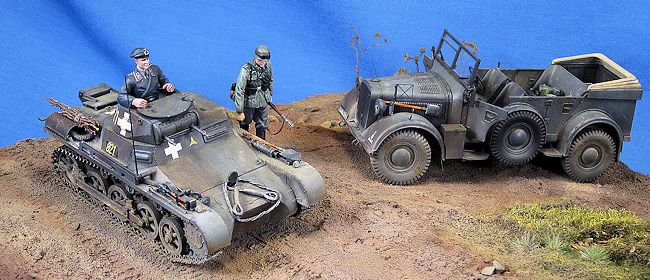 neral
spread mayhem and panic amongst the enemy troops trying to fall back.
While not a revolutionary idea, what made the German model of Blitzkrieg
unique was their belief in the tank.
At a time when the other leading armies of the world still regarded tanks
as secondary to infantry and spent next to nothing on their design and
development, the Wehrmacht recognized that the combination of mobility and
firepower that tanks could provide could give them a lethal advantage on the
battlefield.
neral
spread mayhem and panic amongst the enemy troops trying to fall back.
While not a revolutionary idea, what made the German model of Blitzkrieg
unique was their belief in the tank.
At a time when the other leading armies of the world still regarded tanks
as secondary to infantry and spent next to nothing on their design and
development, the Wehrmacht recognized that the combination of mobility and
firepower that tanks could provide could give them a lethal advantage on the
battlefield.
By the mid-1930s the German armored force was in
full development. The Panzer I and
Panzer II were initially to have been training tanks, but over 3,000 of them
were produced and soon five new Panzer Divisions were training with them.
Panzer parades became common as Hitler defiantly flaunted his growing
forces to the Western Allies, still reeling from the Depression and recovering
from the bloodshed of the Great War.
Behind the threat of that force Hitler invaded a friendly Austria in
March 1938 (2nd Panzer Division was in fact cheered when it entered
Vienna) and not even a month later his Panzers rolled into Czechoslovakia.
In early 1939, Hitler ordered the Army to start planning the invasion of
Poland.
Poland, stuck between Germany to its west and the
Soviet Union to its east, had a fairly respectable army but knew its prospects
for surviving a war with either country were not great.
A few years earlier it had entered into strategic alliances with France
and Great Britain. Hitler sensed
that neither western power had much stomach for another war, but hedged his bets
by insisting that Poland be conquered as quickly as possible in case he had to
shift forces west to block any moves by France.
By August 31st, 1939 the Wehrmacht had some 1.5 million men,
2,500 tanks, and 5,800 artillery pieces massed in two groups on the Polish
border. The stage was set for the
German war machine to showcase its new form of warfare to the world.
At 4 in the morning on September 1st, 1939, the German attack
– and World War Two – began.
The main strategy of the Wehrmacht was a classic
pincer attack – Army Group North and Army Group South were positioned to attack
from the western border of Poland, driving eastwards to meet at Warsaw.
Of the two, Army Group South was larger and more mechanized.
While the going wasn’t as easy as history has since made it out to be, by
September 8th German units were entering the suburbs of Warsaw.
Later Soviet for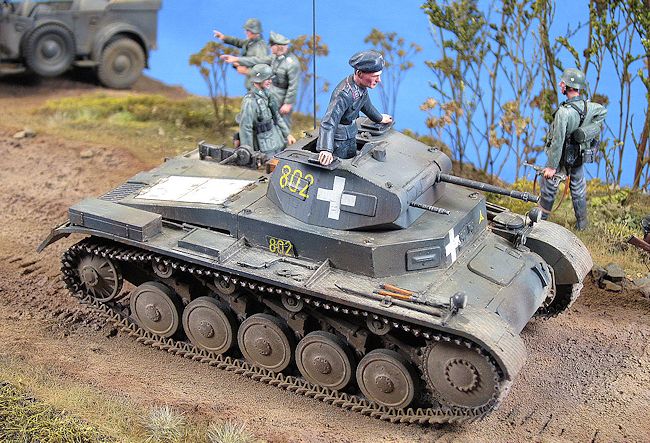 ces
would enter the war against Poland, all but sealing her doom.
On October 1st all fighting ceased in Warsaw, and while the
Polish government never formally surrendered, Poland was in German hands.
France and Britain made threatening overtures and declared war, but just
as Hitler suspected, no moves were made against him.
Armed with a formidable war machine experienced with a new, violent form
of warfare, Hitler began formulating his plans for the invasion of France.
ces
would enter the war against Poland, all but sealing her doom.
On October 1st all fighting ceased in Warsaw, and while the
Polish government never formally surrendered, Poland was in German hands.
France and Britain made threatening overtures and declared war, but just
as Hitler suspected, no moves were made against him.
Armed with a formidable war machine experienced with a new, violent form
of warfare, Hitler began formulating his plans for the invasion of France.
The
purpose of this diorama is to show a column of German armor from the 4th
Panzer Division moving into Poland on the morning of September 1st,
1939. I wanted to convey the idea
that while the armored might of the modern Wehrmacht was impressive, there was a
paradox in that the German Panzer I and Panzer II tanks were in and of
themselves not particularly impressive vehicles.
The scene shows a column of armor and infantry moving down a dirt road,
past a unit photographer.
| THE KITS |
 The
Tristar Panzer I Ausf. A is an excellent kit, highly detailed with very crisply
molded parts, separate plastic track links, and a photo etch fret for the
delicate exhaust screens. Very
similar in quality is the Tamiya Panzer II kit, which keep in mind is a brand
new molding, not their Panzer II from decades ago.
It too features very crisply molded parts as well as plastic “link and
length” tracks and photo etch exhaust screens.
The Italeri Horch kit is of an older vintage and therefore suffers from
slightly softer details, but includes a full interior.
I added an Eduard photo etch set to it to spruce it up a bit.
The
Tristar Panzer I Ausf. A is an excellent kit, highly detailed with very crisply
molded parts, separate plastic track links, and a photo etch fret for the
delicate exhaust screens. Very
similar in quality is the Tamiya Panzer II kit, which keep in mind is a brand
new molding, not their Panzer II from decades ago.
It too features very crisply molded parts as well as plastic “link and
length” tracks and photo etch exhaust screens.
The Italeri Horch kit is of an older vintage and therefore suffers from
slightly softer details, but includes a full interior.
I added an Eduard photo etch set to it to spruce it up a bit.
| CONSTRUCTION |
In
my case I wasn’t going to build or paint the interiors of the tanks, and the
interior of the Horch was going to be the same color as its exterior, so I built
each vehicle straight out of the box without any real modifications.
One of the things I enjoy about building armored fighting vehicles is
that you can assemble each vehicle almost in its entirety before painting.
In my case I built each vehicle completely except for the bogie wheels,
tires, tracks, and pioneer tools.
In parallel with the AFV construction I began
working on the diorama’s base, for which I used a Woodland Scenics 1’ x 2’ x 2”
thick foam sheet. I added some
curves and contours to the base using a hand saw, and then coated the whole top
surface with joint compound. While
the joint compound was still damp I pressed sand and kitty litter into it to
give it some texture. At this time
I also carved tire ruts and tank tracks into the roadway.
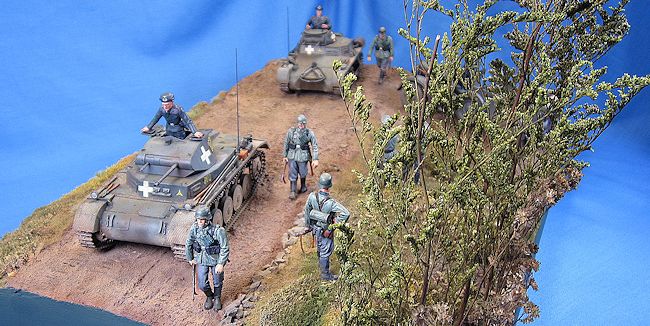 To construct the grassy areas I glued down pieces of
Silflor 8mm tall Late Summer grass matting, and then added regular static grass
around that using white glue mixed with water.
For the trees I used two different types of dried plants I found at my
local big box arts and craft store.
They were attached to the base by drilling small holes and then filling them up
with white glue. To round out the
groundwork I added small amounts of minced up leaves (actual leaves from my
yard) to simulate the typical debris you see in the woods.
To construct the grassy areas I glued down pieces of
Silflor 8mm tall Late Summer grass matting, and then added regular static grass
around that using white glue mixed with water.
For the trees I used two different types of dried plants I found at my
local big box arts and craft store.
They were attached to the base by drilling small holes and then filling them up
with white glue. To round out the
groundwork I added small amounts of minced up leaves (actual leaves from my
yard) to simulate the typical debris you see in the woods.
The figures were made up from a few different kits. I used the Warriors set #35275, “Wehrmacht Trio Walking 1939-45”, Warriors #35297 “Germany Infantryman 1940-43”, Warriors #35311, “German Early War Tank Crew”, and then kitbashed a couple more from various Dragon kits.
| COLORS & MARKINGS |
The first step in painting all three vehicles was to prime
them, so I airbrushed a coat of Mr. Surfacer 1000 onto them.
This was followed by a coat of Testors Panzer Gray.
Recent research has shown that from the beginning of the war until after
the Battle of France, German tanks were camouflaged with a randomly applied
pattern of dark brown over the panzer gray.
To replicate this I sprayed Testors Panzer Schokoladenbraun onto the
vehicles in a random pattern, the final ratio being about 2/3 panzer gray to 1/3
dark brown. At this point I
attached and painted the wheels, tracks, and pioneer tools.
Another nice thing about AFVs – minimal decaling!
I brush painted some Testors Gloss Coat onto the areas that were to
receive decals, and then applied said decals.
After a coat of Testors Flat, I began the weathering process.
I first applied a raw umber pin wash to all of the details.
I followed that by creating some subtle rain streaks by applying dabs of
brown 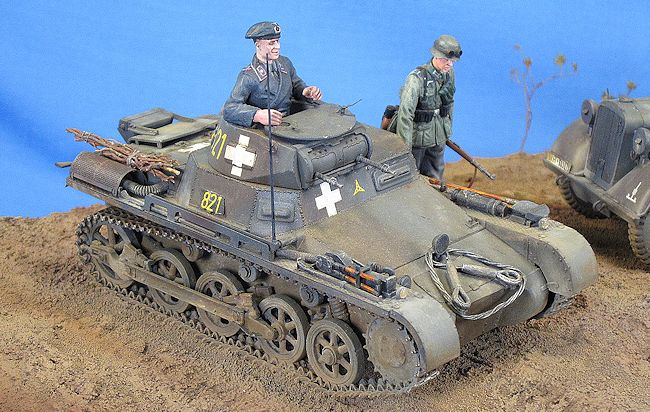 oil
paint and then blending them into the paint using a thinner-soaked brush and
brushing in a downwards motion. I
used MIG Pigments to dirty up the running gear and add some dust to the fenders
and lower parts of the vehicles’ hulls.
I picked out the pioneer tools by hand, and then added some rust colored
pigments to the exhausts. Finally
the tanks’ tracks were given a light dry-brushing of Testors Steel.
oil
paint and then blending them into the paint using a thinner-soaked brush and
brushing in a downwards motion. I
used MIG Pigments to dirty up the running gear and add some dust to the fenders
and lower parts of the vehicles’ hulls.
I picked out the pioneer tools by hand, and then added some rust colored
pigments to the exhausts. Finally
the tanks’ tracks were given a light dry-brushing of Testors Steel.
To paint the scenery I sprayed the grassy areas in a
couple of different shades of green to create some variation in color, and
followed that by dry brushing random areas with Testors Flat Yellow.
Likewise the dirt road was first airbrushed Tamiya XF-72 Brown JGSDF,
followed by some Tamiya XF-59 Desert Yellow to break it up.
Some of the rocks were picked out in gray, and then dusted with MIG
Pigments.
Satisfied with the vehicles and the base, I now had
to paint the figures. For that I
used Vallejo’s acrylics, painting the tunics and helmets Field Gray and then dry
brushing them with some Field Gray that was lightened with white.
The trousers were painted Vallejo Neutral Gray and then washed with a
very dark gray wash. To paint the
dreaded faces I purchased Andrea Miniatures’ Face Painting set.
This set provides you with six different acrylic shades of flesh, and
then walks you through a procedure to get a good looking 1/35 scale face.
I like the final effect and since practice makes perfect (or at least
produces faces that look decent), I will continue to use it in the future.
The personal gear items were picked out by hand; a process I find gets
laborious. By the time you’ve
painted a figure’s face, uniform, personal gear, and gun, you’ve built a very
small but detailed model – and you have to do it a few times!
Still I feel you have to have a lot of figures in your diorama to bring
it to life.
| FINAL CONSTRUCTION |
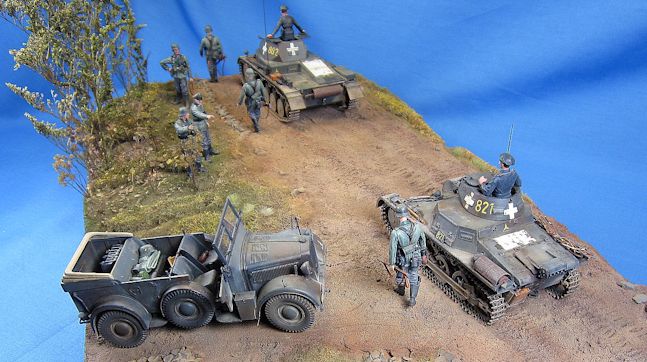 Time to
put it all together. I first glued
the vehicles in place using Walthers Goo.
Then, using white glue and water I added some sand around the tanks’
tracks to make them look as though their weight had caused them to sink into the
road a little bit. This then had to
be painted to match the rest of the base, so I had to airbrush the earth tones I
had used previously to blend the new dirt in.
Time to
put it all together. I first glued
the vehicles in place using Walthers Goo.
Then, using white glue and water I added some sand around the tanks’
tracks to make them look as though their weight had caused them to sink into the
road a little bit. This then had to
be painted to match the rest of the base, so I had to airbrush the earth tones I
had used previously to blend the new dirt in.
To keep the walking figures from falling over I
drilled a tiny hole in each of their feet and inserted a small finishing nail.
This acted as a pin that held them up when inserted into the base.
The other figures were glued onto the base using CA glue.
The final step was to paint the edges of the base with a coat of Dark
Green acrylic craft paint.
| CONCLUSIONS |
A diorama like this takes a while to build, but there’s no
limit on how creative you can be.
While the base and figures take time, I find building an AFV kit is relatively
quick compared to my usual 1/48 airplanes.
With a wealth of new AFV kits and new scenery products coming out all the
time, it’s a great time to build a diorama.
| REFERENCES |
-
Squadron/Signal Publications, Armor in Action #10, “Leichte
Panzers in Action”
-
Concord Publications #6001, “The German Army: Blitzkrieg
1939-41”
- Wikipedia, the Online Encyclopedia
June 2014
If you would like your product reviewed fairly and quickly, please contact the editor or see other details in the Note to Contributors.